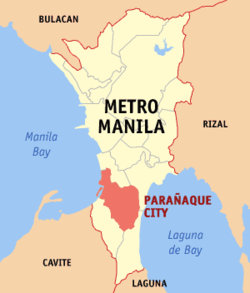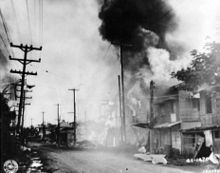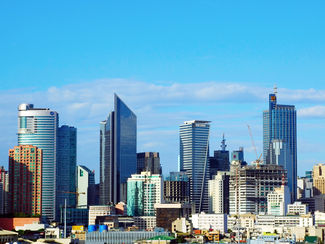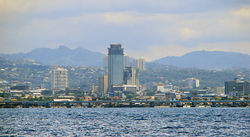Parañaque
| City of Parañaque Lungsod ng Parañaque |
|||
|---|---|---|---|
|
|
|||
|
|||
| Motto: Hataw Parañaque! (Move Forward Parañaque) Pride in Parañaque. Be part of it. |
|||
 |
|||
 City of Parañaque
|
|||
| Coordinates: | |||
| Country | |||
| Region | National Capital Region | ||
| Districts | 1st and 2nd District of Parañaque City | ||
| Barangays | 16 | ||
| Incorporated (town) | November 30, 1572 | ||
| Incorporated (city) | February 15, 1998 | ||
| Government | |||
| - Mayor | Florencio M. Bernabe, Jr. (Lakas-Kampi-CMD) | ||
| - Vice Mayor | Gustavo S. Tambunting (Lakas-Kampi-CMD) | ||
| - Sangguniang Panlungsod |
Councilors
|
||
| Area | |||
| - Total | 47.69 km2 (18.4 sq mi) | ||
| Elevation | 12.0 m (39 ft) | ||
| Population (2000) | |||
| - Total | 449,811 | ||
| - Density | 9,432/km2 (24,428.8/sq mi) | ||
| Time zone | PST (UTC+8) | ||
| Area code(s) | 2 | ||
| Website | www.paranaque.gov.ph | ||
The City of Parañaque (pop. 552,660; 2007 Census), or simply Parañaque (Filipino: Lungsod ng Parañaque), is one of the cities and municipalities that make up Metro Manila in the Philippines.
It is bordered on the north by Pasay City, by Taguig City to the northeast, Muntinlupa City to the southeast, by Las Piñas City to the southwest, and by Manila Bay to the west.
Contents |
History
Parañaque was founded in 1572. Since the place lay very proximate to the sea, the Paraqueños (Parañaquense) did much trade with the Chinese, Indonesians, Indians and Malayans. At that time the main means of livelihood were salt-making, fishing, planting rice, shoemaking, slipper-making and weaving. The community was headed by cabezas de barangay, a westernization of the local chieftains and the principalia as the local aristocrats were called, a very durable social institution since they were the political absorbers. They justified and moderated the demands of the Spanish colonizers. Education was limited to the principalia since it is only they who could afford it. The recorded beginnings of Palanyag began in 1580 when Fr. Diego de Espinar, an Augustinian missionary, was appointed Prior or superior of the convent or religious house of the town. As resident priest, he established the mission house there, with its spiritual jurisdiction reaching up to Kawit in the province of Cavite. The Council of the Definitors (or conference of chiefs of the religious orders) held on May 11, 1580, accepted Palanyag as an independent town. The image of Palanyag's patroness, Nuestra Señora del Buensuceso, was brought to St. Andrew's Church in La Huerta in 1625.
Early Spanish census dated 1591 to 1593 also mentioned Longalo (or Dongalo) and Parañaque as two villages along Manila Bay composed of some 800 tribute-payers. Politically, Dongalo and Parañaque were then under the Provincia de Tondo.
Historical accounts state that since Palanyag was located at the crossroads of Manila, the provinces of Cavite and Batangas, the town's strategic location enabled the townspeople to play an important role in Philippine history. During the invasion of the Chinese pirate Limahong in 1574, Parañaque residents, particularly those from Barangay Dongalo, heroically aided in preventing the attack in Manila. This became known as the "Red Sea Incident" due to the blood that flowed as a result of the defense made by the people from barrio Sta. Monica, the barangay's former name. When the British invaded Manila in 1762, the townspeople once again remained loyal to the Spanish colonizers, especially the Augustinians. The invasion however showed that the power of the Spaniards was not invincible and more than a hundred years later, this would prove to be true. Then came the Philippine Revolution (circa late 19th century) and the Spaniards realized that the town was a practical gateway to Cavite, the bastion of the revolutionary Katipuneros. Conversely to the rebels based in Cavite, they saw the town as their gateway to Intramuros, the Spanish seat of government in Manila. Prominent Paraqueños, like Manuel Quiogue and secular priest Father Pedro Dandan became leading revolutionary figures. When the Americans took over, one of the first towns to have a municipal government was Parañaque.

During the Japanese occupation (circa 1940's), Parañaque supplied the leadership of the guerilla movement like the ROTC Hunters as well as food and arms. Parañaque was one of the first towns to be liberated and its guerillas helped in paving the way for the combined American and Philippine Commonwealth forces to enter the south of Manila. As can be gleaned from the above, Parañaque then and now has and continues to play a strategic role in the Philippines' political and economic progress. Another outstanding feature of this historic town by the bay is the cultivation of its cultural traditions like the Komedya, Sunduan, and Bati-Bati, among others that continue to attract local and foreign tourists alike, especially during the summer months.
On August 21, 1983, Sen. Benigno "Ninoy" Aquino, Jr. (the husband of former Philippine President Corazon Aquino) was assassinated in Manila International Airport (now Ninoy Aquino International Airport) during the Marcos Administration.
From Palanyag to Parañaque
Palanyag, the old name for the city of Parañaque, generally means "my beloved", among other definitions, for as far as its residents are concerned, this best describes their affection for their hometown. Another version came from the combination of the terms "palayan" and "palalayag", the former meaning ricefields of which the city once abounded in and the latter pertaining to the sailing and fishing occupation of many of its residents. This was also a sign of cooperation and goodwill between the two major working sectors of the town, the farmers and the fishermen. It was however a drunken guest, during a certain affair which decided on the final name, who said "Mabuhay ang Palanyag at ang mga taga-Palanyag! (Long live Palanyag and the people of Palanyag!)" So the name stuck from that day on. Another version, according to tradition, was when a Spanish soldier told the driver of his caruaje or horse-drawn carriage, to "Para aqui, para aqui (Stop here, stop here)!" The driver, uncomprehending, kept on prodding his horse to go on while the soldier angrily repeated his instruction: "Para aqui, para aqui!" Onlookers just laughed as the Spaniards empathically said "para aniya aqui para aniya aqui (he said 'stop here' he said 'stop here)." For days the incident was repeated around and term "para aniya aqui" stuck. There is another story that says of an imposing balete tree at the mouth of the Parañaque. It looked like a boat sailing slowly and majestically, earning the Tagalog term Palanyag, a corruption of the term "palayag" which means "point of navigation". Further adulteration of the word later resulted in the word "palanyaque". A historian believes the town's name may have come from the term "palanas" which means a "broad flat plain," the geographic description of Parañaque.
Other origins of the name Parañaque are "palanac" (with no special meaning), "patanyag" or contest for popularity, and "paranac", a native term for the shell product that used to be the livelihood of the natives of the town at one time. Parañaque, in the olden times, was where many people unboard the "kalesa", or horse-drawn carriage and would usually tell the conductor to "para na aque", which literally means "stop now, boy". The word "para", taken from the Spanish word "parar" which means to stop, "na" is a term in the Filipino language which means "now", and "aque" taken from the Filipino term "lalaki" or "lalake", meaning "boy". The phrase "para na aque" was used so often that it eventually evolved into a term pertaining to a place, thus, Parañaque. An alternative meaning of "para na aque" is "stop here", where the term "'aque'" might have also come from the Spanish word "aqui" which means "here". Whatever the correct origin of the name of Parañaque, the various terms strongly suggest the town's storied and mosaic past.
During the Philippine Revolution, Parañaque became one of the hottest battle zones due to its location halfway between the province of Cavite, where the revolutionaries held sway, and Manila, the seat of the Spanish colonial government.
During the American occupation of the Philippines, Parañaque became one of the first municipalities in the Metro Manila region.
Cityhood
Parañaque City was converted as the 11th city in Metro Manila (after sister city Las Piñas City in 1997, the following year later), and chartered and urbanized city by Former President Fidel V. Ramos on February 15, 1998, also the celebration of Parañaque City's 426th Founding Anniversary.
Parañaque City Today
In March 2000, Habalo Bldg. in BF Homes Paranaque City was launched were also opened their very 1st Starbucks Branch in Paranaque City.
In November 2002, Paranaque City celebrated their 430th Founding Anniversary of the municipality and now a city also launched 4 years ago in 1998.
In May 2001, SM City Sucat (Formerly SM Supercenter Sucat) was formally launched, and it became the 1st SM Mall Franchise in Parañaque City, the Supercenter was changed later to SM City, and it became a larger and wider mall.
In November 2002, the second SM City mall in Parañaque City was launched, SM City Bicutan, becoming one of the most popular malls in Parañaque City after Uniwide Coastal Mall.
In February 2003, the City of Parañaque celebrated their 5th Cityhood Anniversary.
In September 2007, the first strip mall located in Sucat, Parañaque City was "Santana Grove". It has more than 10 restaurants and 1 coffee house chain.
In November 2007, Paranaque City celebrated their 435th anniversary of a former municipality now a city.
In February 2008, the City of Parañaque celebrated their 10th Cityhood Anniversary.
In April 2008, the Pergola Lifestyle Mall in BF Homes was formally opened and launched.
In February 2009, Speedworld Motorcross Racing Park was formally opened beside SM Bicutan in West Bicutan, Paranaque City.
In spite of the rapid growth in infrstructure and the revenue that the city has been gaining in the last few years, Parañaque has yet to go back to its "subdivision" roots and address the rising reports in crime - burglary, holdups, rape and streetgang violence. Most recently, the city has been plagued with crimes involving current call center workers in and around the city. With the upswing in the call center business in last 2 years, Parañaque has yet publicly come out and identify contingencies measures and visibility to protect these wave of employees who are mostly graveyard - 9:00pm to 9:00am, shift workers.
Etymology
The name "Parañaque" is derived from the phrase "para na aque," which was commonly used in the past when people wished to disembark from kalesas (horse-drawn carriages). The phrase literally means "stop now, boy": "para" from the Spanish parar (to stop), "na" from the Tagalog word for "now" or "already," and "aque" from the Tagalog word for boy, lalaki. An alternative meaning of "para na aque" could be "stop here," with "aque" being derived from the Spanish aquí ("here").
Notable residents
- Joey Marquez- Actor/Comedian/Former City Mayor
- Anjo Yllana- Actor/Comedian/Former Councilor and City Vice-Mayor
- Ryan Yllana- Actor/Comedian/Councilor (2nd District)
- Val Sotto - Actor/Comedian/Councilor (2nd District)
- Bianca Gonzalez- TV Host, Pinoy Big Brother: Celebrity Edition 3rd Celebrity Placer
- Say Alonzo- Actress, Pinoy Big Brother Season 1 Housemate
- Stef Prescott- Actress, StarStruck Batch 4 Avenger Alumni
- Joaqui Mendoza- Taekwondo jin, Pinoy Big Brother: Teen Edition Housemate
- Dimples Romana- Actress
- Alma Moreno- Actress/Councilor 1st District
- Sam Pinto- Actress, Pinoy Big Brother: Double Up Housemate
- Cris Pastor- Pinoy Dream Academy Season 2 Scholar
- Ted Failon- Broadcaster/TV Host
- Roselle Nava- Singer/Actress/Councilor 1st District
- Geoff Eigenmann- Actor/TV Host
- Freddie Webb- Actor/Radio Host/Former PBA Player and Senator
- Pinky Webb- Broadcaster/TV Host
- Jason Webb- Former Basketball player/Councilor 1st District
- Mariel Rodriguez- Actress/TV Host/Former MTV VJ
- Karen Davila- Broadcaster/TV Host/Reporter
- Korina Sanchez- Broadcaster/TV Host
Government
Mayors of Parañaque City
- Mayor Florencio "Jun" M. Bernabe, Jr. (2004–present)
- Joey P. Marquez (1995–2004)
- Pablo "Doc" R. Olivarez (1992–1995)
- Walfredo "Wally" Ferrer (1988–1992)
- Rodolfo G. Buenavista OIC (1986–1988)
- Florencio Bernabe, Sr. (1972–1986)
- Col. Eleuterio de Leon (1963–1972)
- Ramon Pascual (1954–1963)
Districts and barangays
Parañaque is composed of two congressional districts and two legislative districts which are further subdivided into 16 Barangays. Legislative District One contains eight barangays in the western half of the city, while legislative District Two contains the eight barangays in the eastern portion of the city.
While barangays are the administrative divisions of the city, and are legally part of the addresses of establishments and homes, many residents indicate their subdivision (village) instead of their barangay.
Listed below are the barangays in each district and some notable subdivisions.
District 1 BarangaysDistrict 2 BarangaysEducationParañaque City has a diverse educational system with specializations in various academic and technical fields and is home to many schools and colleges. Special points of interest by Paranaque City
TransportationRail TransportParañaque is served by the LRT-1 (via Baclaran Station, which is located in Pasay City) and the PNR (via Bicutan station). AirportParañaque is also the location of Ninoy Aquino International Airport but only one terminal is located here in this city. The terminal of NAIA in Parañaque is the Old Terminal or Terminal 1 located along Ninoy Aquino Avenue. Road NetworkParañaque is accessed by these following major roads:
For other major roads, see Major roads in Metro Manila Sister cities
Trivia
See also
External links
|
|||||||||||||||||||||||||||||||||||||||||||||||||||||||||||||||||||||||||||||||||||||||||||||||||||||||||||||||



